Before Amy Fusselman made a name for herself in the world of publishing as the author of books like Savage Park: A Meditation on Play, Space and Risk for Americans Who Are Nervous, Distracted and Afraid to Die (Houghton Mifflin Harcourt, 2015), The Pharmacist’s Mate (McSweeney’s, 2013), and 8 (McSweeney’s, 2013), she produced the delightfully engaging little zine Bunnyrabbit. Like all the most memorable zines, Bunnyrabbit created and maintained its own unique universe, a place where, as a reader, you felt fortunate to have been invited into. Not only was there brilliant writing about all those things in life that Amy felt drawn toward, but it was all woven together by her beautifully raw illustrations, and occasionally accompanied by her own voice, which was included by way of audio cassette, taped to the back cover. [I’ve been looking through my archives for the Bunnyrabbit tape that included Amy covering Ace of Spades by Motörhead, thinking that I could include it here, but to no avail.] Following is my recent conversation with Amy about the origins of Bunnyrabbit, what she’s been up to since we used to be pen pals, and her upcoming book, Idiophone, which will be released from Coffee House Press this next July.
MARK: Do you know the story of your birth?
AMY: That’s such an interesting question. Yes, I know the things that were told to me–among them that my gender was a surprise and that my mother exclaimed, upon hearing the news, that I was “going to make everyone so happy,” which is sort of funny because she had very mixed feelings about me.
MARK: Can you elaborate on these “mixed feelings” that your mother had?
AMY: I’m working on a book which includes it, so not right now.
MARK: Have you started the process of interviewing your mother for it?
AMY: It’s in process, yes.
MARK: I won’t push. [I can wait for the book.] But I’m curious about your relationship with your mother, and her how, if at all, it might have been affected by your writing, some of which has been quite personal.
AMY: My relationship with my mother hasn’t been affected by my writing.
MARK: What’s the most interesting question you’ve ever been asked?
AMY: I can’t think of one offhand but my kids ask a lot of “why” questions and I like those a lot. You have to dig into the why questions.
MARK: Have you ever seen Inside The Actors Studio? James Lipton always asks the same questions, stolen from Bernard Pivot. While I like mine better, I try to mix some of Pivot’s in on occasion. With that in mind… “What profession would you not like to do?”
AMY: I would not want to be a garbage person, although I am so grateful for their work.
MARK: Back to the beginning… Were you the first child?
AMY: No, the second and last.
MARK: What were your parents like?
AMY: My mother is still alive. My dad was a good guy. They are/were white Midwesterners.
MARK: As a white Midwesterner, I hope that’s not how my life will been summed up, once the ledger is closed. It is, though, accurate. If I had to choose two words for myself, I’m thinking maybe they’d be, “he tried.” What two words would you aspire to? What would you like to have written next to your name, when all has been said and done?
AMY: My two words would be “YES AND,” which is a phrase I learned from taking my sons to improv class.
MARK: What’s your first memory?
AMY: I am lying in my crib holding my favorite stuffed giraffe.
MARK: It’s funny how many people that I pose that question to respond with answers about their cribs, myself included. It kind of makes me think that we should invest in making cribs nicer.
AMY: Maybe because in the crib the parents left us alone. We could have the time/space to have a significant thought. Cribs are like baby Yaddos.
MARK: Do you still have the stuffed giraffe?
AMY: No, but my daughter’s stuffed animal collection is vast. There’s undoubtedly a giraffe in there.
MARK: If you had a “Rosebud,” like Charles Foster Kane, what would it be?
AMY: That’s a tough one. I’d have to think about that for a few more years.
MARK: And where was your crib, geographically speaking?
AMY: In Connecticut, where I lived until the end of first grade.
MARK: What was it that brought your family to Connecticut, and why was it that they left?
AMY: My dad had been working in Detroit, at Ford. He then got a job at JC Penney in NYC and my family lived in Connecticut while my dad commuted to NYC for work. I frequently walk past the building where my dad worked.
MARK: Did you have a JC Penney discount?
AMY: I wore a lot of their clothing, I’m sure.
MARK: And why did you leave Connecticut?
AMY: My father got another job, this one in Minneapolis. We lived there for a few years before we moved to Ohio.
MARK: And is it Ohio that you consider home? Is that where you went to high school, and met the adult version of yourself?
AMY: Ohio is where both my parents as well as my husband were born and raised. It’s where my family comes from. But at this point, New York City is my home.
MARK: Was all the moving difficult for you? We did quite a bit of it too, when I was young, and I think it led me to be more solitary than perhaps I would have been by nature. Then again, I think it may have also made me more creative, aware of my surroundings, etc.
AMY: It made me more resilient, I’ll say that.
MARK: What kind of child were you?
AMY: Very anxious and very hard working.
MARK: When did you know that you wanted to be a writer?
AMY: Starting around middle school.
MARK: What were you writing in middle school?
AMY: I wasn’t writing much, I don’t think. But I loved to read and I had the idea that I wanted to join these people whose writing I was reading.
MARK: What was the first interesting thing that you remember writing?
AMY: I wrote a poem in 6th grade that was chosen for publication in the school literary mag. I was happy about it but also so nervous that I didn’t want it published under my real name. They ran it “by Anonymous.”
MARK: OK, let’s talk about your curious, little zine, Bunnyrabbit. How did it come about? Do you recall what made you decide to enter the world of the underground press?
AMY: I had just gotten my master’s in creative writing and I knew the next step was that I was supposed to be sending my poems out to little journals. I really did not want to do that. It seemed so hopeless and sad and I didn’t have the capacity for handling a lot of rejection then. I noticed these ‘zines at Tower Records and thought this would be a way to get my work out that would be more fun.
[above: The original Bunnyrabbits. Photo by Todd Colby.]
MARK: So, was it at Tower Records that you first became aware that there were people out there in the world, publishing their own stuff?
AMY: Yes. Thank God for Tower.
MARK: Would that have been the New York City Tower? What would the year have been?
AMY: Yes, on West 4th. I lived on Thompson and then West 11th. This would have been, hmmm…mid 90s?
MARK: I had a great conversation not too long ago with Doug Biggert about his decision to carry zines at Tower. Did you have any interactions with Doug? If so, what do you remember?
AMY: Oh, absolutely. He called me one day to say that Tower wanted to distribute Bunnyrabbit internationally. I think that’s the only time I ever spoke to him, but it was a big deal for me.
MARK: You mentioned your capacity for handling rejection. Can you talk about how you came to the point where you were comfortable sending out copies of Bunnyrabbit, and other things that you’d written?
AMY: There’s no way around it but through. I straightened out my relationship with the publishing world in the sense that I began to understand better what I wanted from writing. Also, I found Rilke’s advice in Letters to a Young Poet. I love this quote:
You ask whether your verses are any good. You ask me. You have asked others before this. You send them to magazines. You compare them with other poems, and you are upset when certain editors reject your work. Now (since you have said you want my advice) I beg you to stop doing that sort of thing. You are looking outside, and that is what you should most avoid right now. No one can advise or help you—no one.
MARK: What zines were you reading prior to launching Bunnyrabbit?
AMY: I was really interested in what Dishwasher Pete was doing–that kind of documenting. I loved how anti-elitist it was, which I’d say was a hallmark of the zine movement in general. I was very into comics at the time as well. My husband (then boyfriend) Frank and I were obsessed with Daniel Clowes’ Eightball.
MARK: When I talked with Pete for this series of interviews, a good deal of our time was spent discussing how Dishwasher had been an attempt to build community. In addition to just finding an outlet for your writing, were you… to put it way too simply… looking for friends? Were you trying to find a community of like-minded folks out there? Was Bunnyrabbit kind of a message-in-a-bottle?
AMY: Definitely. That sense of community was very important to me at the time. I still have a bunch of the letters–paper letters!–I received from readers, many of whom were other zine makers.
MARK: Do you miss that now… the joy of going to the mailbox and finding letters waiting for you from readers, telling you about how they found Bunnyrabbit? Or do you get the same kind of satisfaction from the emails that come in through your site from readers of your books and articles?
AMY: People do reach out to me but it’s not quite the same as that period in the zine community.
MARK: Where there other names that you considered before landing on Bunnyrabbit? Do you recall any of them?
AMY: I don’t think so. The idea was that Bunnyrabbit was going to have a piece of sandpaper pasted onto every cover. I liked riffing on the expectation that Bunnyrabbit would be soft. I was thinking about it as an object as well as a piece of writing. The children’s book, Pat the Bunny, is also in there somewhere.
MARK: How is it that I don’t remember the sandpaper? Was it perhaps gone by the time that I started reading, or did you just give up on the conceit early on?
AMY: I can assure you that it was real sandpaper. It was a pain in the ass to cut and paste, plus it ruined multiple pairs of scissors. I did it through the first 3 or 4 issues, at least. It’s possible it dropped off in the stress of mailing.
MARK: More likely, I just don’t remember it. I’ve noticed my memory has been fading a bit these past several years… I’m not enjoying the process of aging very much. Are you?
AMY: I am enjoying it in the sense that I am a very late bloomer so aging has been wonderful for me. I am also much better at discernment now. I don’t sign on for things unless I really want to do them.
MARK: So this interview is something that you really want to do? That makes me happy.
AMY: Yes, I’m really glad you reached out to me, Mark.
MARK: Speaking of bunny rabbits, I was just reading that Mike Pence has signed a book deal on behalf of his pet rabbit, Marlon Bundo. It’s going to be called, “Marlon Bundo’s ‘A Day in the Life of the Vice President’”. I’m not sure what that says about the current state of the publishing industry, or our country, but I thought that I should mention it… For what it’s worth, my hope is that Bundo is absolutely ruthless… like even worse that Kitty Kelley.
AMY: That’s really funny. I recently saw a book at a mall bookstore that was “How to Talk to Your Cat About Gun Safety.” It was “Presented by The American Association of Patriots.” I was struck by that–there’s not even an author, just a “presented by.” It’s a gesturing towards the text, rather than a claiming of it, which seems to be a popular stance these days. The stakes are lower.
MARK: Things do seem to be trending toward anonymity, and away from accountability, in a general sense. I mean, it would appear as though our last presidential election was just won, at least in part, by anonymous conspiracy memes disseminated via Facebook… But let’s talk about you. Do I understand correctly that you once opened for the Minutemen?
AMY: Yes, we opened for them. They were amazing, of course.
MARK: If we were to make a movie of your life, how would the exchange between you, D. Boon and Mike Watt play out? And who would you like to have play the young Amy Fusselman?
AMY: Oh lord. I don’t think I even spoke to them. I was doing a lot of internal work just to get up on stage–it was only our third show!
MARK: And as for who in popular culture might convey the essence of a young Amy Fusselman during this silent encounter with the Minutemen?
AMY: Haha, silent encounters are my forte. I would play myself.
MARK: What was your band, and where was it that you were playing?
AMY: It was a punk rock band. We played at Stache’s, which is where I saw pretty much everything. I had some religious experiences at that club. I saw The Butthole Surfers, Big Black, Pussy Galore, Sonic Youth, Redd Cross, Frightwig… so many great shows. Frank and I were also DJs at the college radio station and we were just totally immersed in music at that time. And Scrawl was a band we were friends with in town and I saw them play many times and they were just beyond. So powerful.
MARK: I’m seeing a Stache’s in Columbus, Ohio, as well as in Fort Lauderdale, Florida. Would I be right to assume that you were in Ohio?
AMY: Yes, Columbus. I did my undergrad at Ohio State, which is where I met Frank. He was the lead singer in the band and I played guitar.
MARK: Back to Bunnyrabbit, can you walk us through the process of pulling together and printing that first issue, from conception to publication?
AMY: I wrote the pieces on the computer and then did the illustrations and laid it all out on copy paper and took those master copies down to the copy place on west 12th street. I didn’t second guess myself much, which was a strength. It was the opposite of waiting for an acceptance from a poetry journal. It was like fuck you, I am making a magazine.
MARK: So it wasn’t that you had written the stories already, looking to have them published elsewhere…
AMY: No, no. It was the decision to make a zine and then fitting words/images into that format.
MARK: Were you working at that time in your life? If so, what were you doing?
AMY: Yes, after I landed in New York, I got a job at the Brooklyn Public Library. I did PR for them. Go Library!
MARK: How did you know what would be a Bunnyrabbit-appropriate story? Were there criteria that you considered?
AMY: Only that I had to like the material a lot, which I did.
MARK: And, where, in the Bunnyrabbit journey, did our paths cross?
AMY: Mark, I don’t even know!! How did I get my first Crimewave? And what a great title that was!
MARK: I can’t recall which way the first trade went. Either you saw Crimewave at Tower Records, or we read about Bunnyrabbit in Factsheet Five. I’m guessing it would have been around ‘94 or ‘95, as I think we met in person the summer of ‘95, in New York. I remember because I think it was the night before the very first Monkey Power Trio session. [We’ve since gone on to play one-day-a-year for the past 22 years.] Linette and I were both incredibly touched by the fact that you made the effort to come out and find us at some bar. I remember you being super friendly, and maybe wearing a bright blue jacket.
AMY: I remember that! Yes, it was great to meet you there. I like that you are doing that one-day-a-year gig.
MARK: Is there still music in your life?
AMY: Yes, but the relationship has changed. I live in an apartment with four other people and overwhelmingly the thing I want most is quiet and I don’t get it that much.
MARK: So, why did Bunnyrabbit end? And what happened between the end of Bunnyrabbit and the first book — the one published by McSweeney’s?
AMY: I think once the McSweeney’s book happened I thought I could do this writing thing another way. I still think about zines, though, and about getting back to drawing more.
MARK: So, was Bunnyrabbit going right up to the McSweeney’s deal?
AMY: I don’t remember. Probably, though.
MARK: For folks who might not be aware of what we mean by “the McSweeney’s deal,” can you fill people in on what happened?
AMY: I won a contest McSweeney’s ran in which I was won the opportunity to write a book about electrical engineering on boats. That book is “The Pharmacist’s Mate,” which is about my dad’s dying during the time I was trying to get pregnant with my first kid. My dad was a pharmacist’s mate on a Liberty Ship in WW II and I used pieces of his diary in the text. The Pharmacist’s Mate, along with 8, are being released this month in Italian from Black Coffee Edizioni.
MARK: While I absolutely love your writing, it was your drawings that really interested me early on. They kind of reminded me of John Lennon’s work. I liked yours better, though. I know it may sound odd, but they came across as super honest.
AMY: Thank you. The drawings knew where I was going before the writing did, I think. They were a good navigational tool for me.
[above: An illustration from Bunnyrabbit.]
MARK: I should add that Linette and I have enjoyed following your career. It was always nice to see your work show up in unexpected places, like Raw Vision, which was my favorite magazine. And we’ve bought the books, of course. Also, up until recently, Linette has taught Bunnyrabbit in the zine class she teaches at Eastern Michigan University… At any rate, it’s been a delight to watch you grow as a writer and make a name for yourself in the industry.
AMY: That’s so sweet of you, Mark. Yes, Linette was very kind in including Bunnyrabbit in that class. It seemed like a great class.
MARK: So, shall we talk about the books?
AMY: Yes, but first I want to add that I am still publishing. I edit a digital art/lit journal called Ohio Edit. We sell 99-cent downloadable essays and also have a blog where we run poetry, prose, and multimedia. We have two beautiful essays up for sale now by Nicholas Spice and David Robbins. And we have poetry collections coming soon from Nancy Kangas and Gilmore Tamny.
And yes, I have a book coming out in July from Coffee House Press called IDIOPHONE and I love it and hope you do, too! It’s a really unusual, funny, crabby piece of work. It’s about a musical instrument called a slit gong, which is a type of idiophone. I love those words: SLIT GONG.
MARK: And how did you come to find yourself in the world of the slit gong?
AMY: This particular slit gong is on display at the Metropolitan Museum of Art.
MARK: I have a friend who perhaps suffers from a similar affliction. He went to Kenya and got himself hooked on an instrument called a nyatiti, and now it can’t seem to break free of its grasp. It’s a huge part of his life now. He’s writing about it. He’s making a documentary. It’s all he really wants to talk about.
AMY: I bristle at your describing this as an affliction! Just listen to that word: nyatiti! How can he say anything else?
[above: An illustration from Bunnyrabbit.]
[note: The two illustrations above were taken from a Bunnyrabbit interview with Paul Kelly, in which the filmmaker talks about his pre-birth memories. A scan of the interview can be found here: part one, part two.]
[If you like what you’ve read and want to learn more about the American underground press and the people behind it, be sure to check the other interviews in the History of Zines series.]

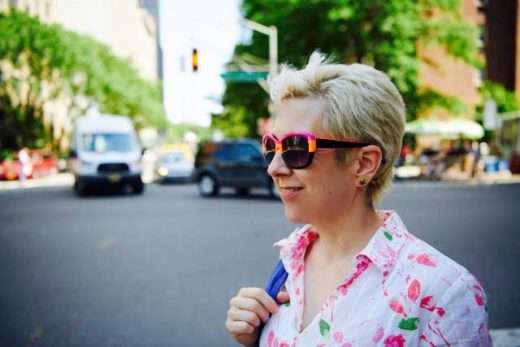
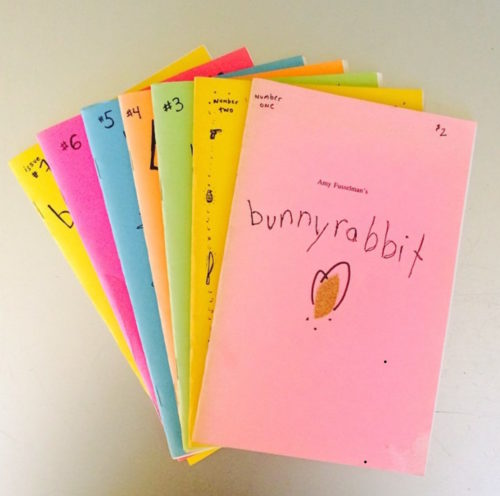
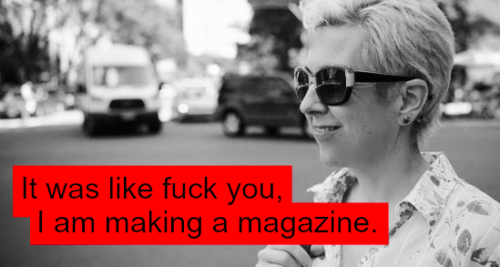
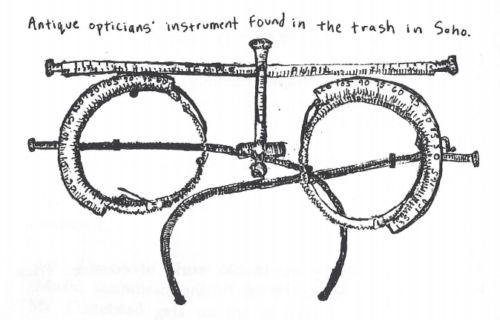
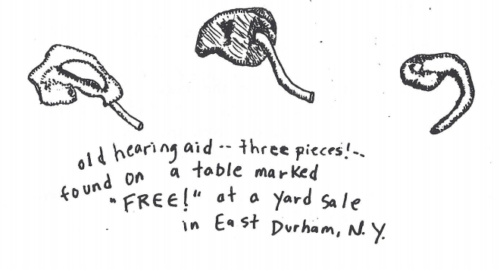







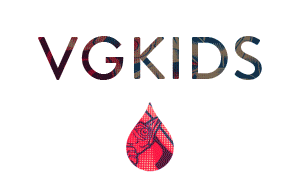



3 Comments
One of the best zines ever.
I read Savage Park and loved it. I wasn’t aware that Fusselman had started out as a zine publisher. Thank you for sharing this.
Bunny Rabbit was a revelation. Those copies should be a vault! Great interview!
One Trackback
[…] When I interviewed Amy Fusselman for this series, she mentioned that she played in a punk band that once opened for The Minutemen. I felt as though […]